Submitted:
16 July 2023
Posted:
17 July 2023
You are already at the latest version
Abstract
Keywords:
1. Introduction
2. Material and Methods
2.1. Microgrid Design
2.1.1. CHP
2.1.2. Solar PV, Energy storage battery, and Inverter
2.1.3. Wind Turbine (WT)
2.1.4. Cost Parameters
3. Results and Discussion
3.1. Microgrid Setting Up
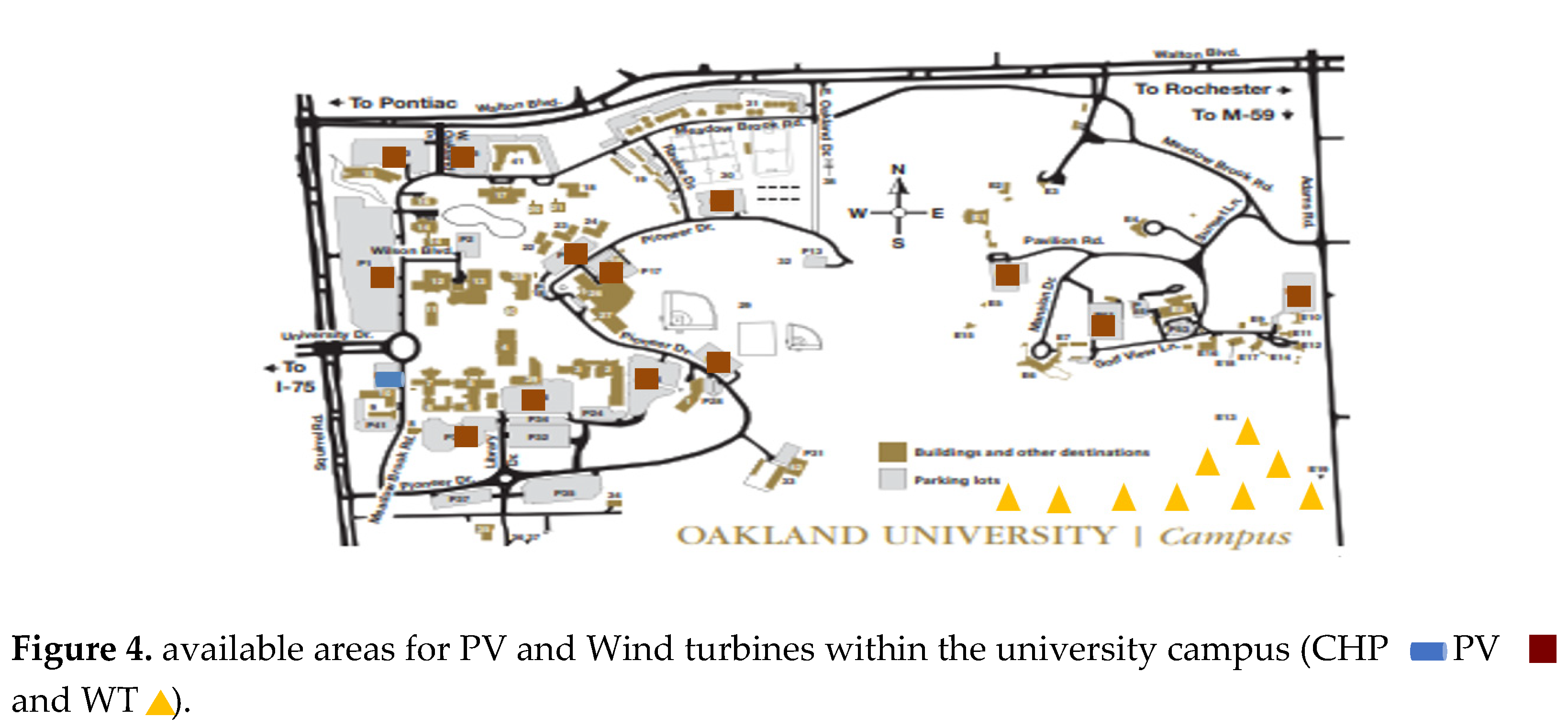
3.2. System Configurations Simulation Results
3.3. Determination of Oakland University System
3.4. Unmet Electrical Load
4. Conclusions
Author Contributions
Funding
Data Availability Statement
Acknowledgments
Conflicts of Interest
References
- T. S. Uyar and N. Javani: Renewable Energy Based Solutions, vol. 87. in Lecture Notes in Energy, vol. 87. Cham: Springer International Publishing AG, 2022. [CrossRef]
- H. Elsaraf, M. Jamil, and B. Pandey, “Techno-Economic Design of a Combined Heat and Power Microgrid for a Remote Community in Newfoundland Canada,” IEEE Access, vol. 9, pp. 91548–9 1563, 2021. [CrossRef]
- M. Kantola and A. Saari, “Renewable vs. traditional energy management solutions – A Finnish hospital facility case,” Renew. Energy, vol. 57, pp. 539–545. 2013. [CrossRef]
- M. F. Ishraque et al., “Techno-Economic and Power System Optimization of a Renewable Rich Islanded Microgrid Considering Different Dispatch Strategies,” IEEE Access, vol. 9, pp. 77325–7 7340, 2021. [CrossRef]
- İ. ÇetınbaŞ, B. Tamyürek, and M. Demırtaş, “The Hybrid Harris Hawks Optimizer-Arithmetic Optimization Algorithm: A New Hybrid Algorithm for Sizing Optimization and Design of Microgrids,” IEEE Access, vol. 10, pp. 19254–1 9283, 2022. [CrossRef]
- N. Anglani, G. N. Anglani, G. Oriti, R. Fish, and D. L. Van Bossuyt, “Design and Optimization Strategy to Size Resilient Stand-Alone Hybrid Microgrids in Various Climatic Conditions,” IEEE Open J. Ind. Appl., vol. 3, pp. 237–246. 2022. [Google Scholar] [CrossRef]
- S. Pandey et al., “Multi-Criteria Decision-Making and Robust Optimization Methodology for Generator Sizing of a Microgrid,” IEEE Access, vol. 9, pp. 142264–142275 2021. [CrossRef]
- M. E. Sallam, M. A. Attia, A. Y. Abdelaziz, M. A. Sameh, and A. H. Yakout, “Optimal Sizing of Different Energy Sources in an Isolated Hybrid Microgrid Using Turbulent Flow Water-Based Optimization Algorithm,” IEEE Access, vol. 10, pp. 61922–61936 2022. [CrossRef]
- M. H. Moradi, M. M. H. Moradi, M. Hajinazari, S. Jamasb, and M. Paripour, “An energy management system (EMS) strategy for combined heat and power (CHP) systems based on a hybrid optimization method employing fuzzy programming,” Energy Oxf., vol. 49, no. 1, pp. 86–101. 2013. [Google Scholar] [CrossRef]
- S. Dhundhara, Y. P. S. Dhundhara, Y. P. Verma, and A. Williams, “Techno-economic analysis of the lithium-ion and lead-acid battery in microgrid systems,” Energy Convers. Manag., vol. 177, pp. 122–142, Dec. 2018. [Google Scholar] [CrossRef]
- M. Amini, A. M. Amini, A. Khorsandi, B. Vahidi, S. H. Hosseinian, and A. Malakmahmoudi, “Optimal sizing of battery energy storage in a microgrid considering capacity degradation and replacement year,” Electr. Power Syst. Res., vol. 195, p. 107170, Jun. 2021. [Google Scholar] [CrossRef]
- H. Khorramdel, J. H. Khorramdel, J. Aghaei, B. Khorramdel, and P. Siano, “Optimal Battery Sizing in Microgrids Using Probabilistic Unit Commitment,” IEEE Trans. Ind. Inform., vol. 12, no. 2, pp. 834–843, Apr. 2016. [Google Scholar] [CrossRef]
- M. Kharrich et al., “Developed Approach Based on Equilibrium Optimizer for Optimal Design of Hybrid PV/Wind/Diesel/Battery Microgrid in Dakhla, Morocco,” IEEE Access, vol. 9, pp. 13655–1 3670, 2021. [CrossRef]
- M. Nakiganda, S. M. Nakiganda, S. Dehghan, U. Markovic, G. Hug, and P. Aristidou, “A Stochastic-Robust Approach for Resilient Microgrid Investment Planning Under Static and Transient Islanding Security Constraints,” IEEE Trans. Smart Grid, vol. 13, no. 3, pp. 1774–1788, May 2022. [CrossRef]
- Y. Sahri et al., “Performance improvement of Hybrid System based DFIG-Wind/PV/Batteries connected to DC and AC grid by applying Intelligent Control,” Energy Rep., vol. 9, pp. 2027–2043, Dec. 2023. [CrossRef]
- S. P. Bihari et al., “A Comprehensive Review of Microgrid Control Mechanism and Impact Assessment for Hybrid Renewable Energy Integration,” IEEE Access, vol. 9, pp. 88942–8 8958, 2021. [CrossRef]
- H. Wang and J. Huang, “Joint Investment and Operation of Microgrid,” IEEE Trans. Smart Grid, vol. 8, no. 2, pp. 833–845, Mar. 2017. [CrossRef]
- M. Nurunnabi, N. K. Roy, E. Hossain, and H. R. Pota, “Size Optimization and Sensitivity Analysis of Hybrid Wind/PV Micro-Grids- A Case Study for Bangladesh,” IEEE Access, vol. 7, pp. 150120–15 0140, 2019. [CrossRef]
- H. U. R. Habib, S. Wang, M. R. Elkadeem, and M. F. Elmorshedy, “Design Optimization and Model Predictive Control of a Standalone Hybrid Renewable Energy System: A Case Study on a Small Residential Load in Pakistan,” IEEE Access, vol. 7, pp. 117369–11 7390, 2019. [CrossRef]
- Y. Yang, Q. Y. Yang, Q. -S. Jia, G. Deconinck, X. Guan, Z. Qiu, and Z. Hu, “Distributed Coordination of EV Charging With Renewable Energy in a Microgrid of Buildings,” IEEE Trans. Smart Grid, vol. 9, no. 6, pp. 6253–6264, Nov. 2018. [Google Scholar] [CrossRef]
- S. Rehman, H. U. R. Habib, S. Wang, M. S. Büker, L. M. Alhems, and H. Z. Al Garni, “Optimal Design and Model Predictive Control of Standalone HRES: A Real Case Study for Residential Demand Side Management,” IEEE Access, vol. 8, pp. 29767–2 9814, 2020. [CrossRef]
- H. Elsaraf, M. Jamil, and B. Pandey, “Techno-Economic Design of a Combined Heat and Power Microgrid for a Remote Community in Newfoundland Canada,” IEEE Access, vol. 9, pp. 91548–9 1563, 2021. [CrossRef]
- Parida, S. Choudhury, and D. Chatterjee, “Microgrid Based Hybrid Energy Co-Operative for Grid-Isolated Remote Rural Village Power Supply for East Coast Zone of India,” IEEE Trans. Sustain. Energy, vol. 9, no. 3, pp. 1375–1383, Jul. 2018. [Google Scholar] [CrossRef]
- Kumar, A. R. Singh, Y. Deng, X. He, P. Kumar, and R. C. Bansal, “Multiyear Load Growth Based Techno-Financial Evaluation of a Microgrid for an Academic Institution,” IEEE Access, vol. 6, pp. 37533–3 7555, 2018. [Google Scholar] [CrossRef]
- M. Nurunnabi, N. K. Roy, E. Hossain, and H. R. Pota, “Size Optimization and Sensitivity Analysis of Hybrid Wind/PV Micro-Grids- A Case Study for Bangladesh,” IEEE Access, vol. 7, pp. 150120–15 0140, 2019. [CrossRef]
- L. H. S. Santos, J. A. A. L. H. S. Santos, J. A. A. Silva, J. C. López, N. B. Arias, M. J. Rider, and L. C. P. Da Silva, “Integrated Optimal Sizing and Dispatch Strategy for Microgrids Using HOMER Pro,” in 2021 IEEE PES Innovative Smart Grid Technologies Conference - Latin America (ISGT Latin America), Sep. 2021, pp. 1–5. [CrossRef]
- İ. Çetinbaş, B. Tamyürek, and M. Dermitas, “Design, Analysis and Optimization of a Hybrid Microgrid System Using HOMER Software: Eskişehir Osmangazi University Example,” Int. J. Renew. Energy Dev., vol. 8, no. 1, pp. 65–79. 2019. [Google Scholar] [CrossRef]
- Belmahdi and A., E. Bouardi, “Simulation and Optimization of Microgrid Distributed Generation: a Case Study of University Abdelmalek Essaâdi in Morocco,” Procedia Manuf., vol. 46, pp. 746–753. 2020. [Google Scholar] [CrossRef]
- V. V. V. S. N. Murty and A. Kumar, “Optimal Energy Management and Techno-economic Analysis in Microgrid with Hybrid Renewable Energy Sources,” J. Mod. Power Syst. Clean Energy, vol. 8, no. 5, pp. 929–940, Sep. 2020. [CrossRef]
- H. Li, Z. H. Li, Z. Ren, A. Trivedi, P. P. Verma, D. Srinivasan, and W. Li, “A Noncooperative Game-Based Approach for Microgrid Planning Considering Existing Interconnected and Clustered Microgrids on an Island,” IEEE Trans. Sustain. Energy, vol. 13, no. 4, pp. 2064–2078, Oct. 2022. [Google Scholar] [CrossRef]
- Cetinbas, B. Tamyurek, and M. Demirtas, “The Hybrid Harris Hawks Optimizer-Arithmetic Optimization Algorithm: A New Hybrid Algorithm for Sizing Optimization and Design of Microgrids,” IEEE Access, vol. 10, pp. 19254–1 9283, 2022. [Google Scholar] [CrossRef]
- S. Dhundhara, Y. P. S. Dhundhara, Y. P. Verma, and A. Williams, “Techno-economic analysis of the lithium-ion and lead-acid battery in microgrid systems,” Energy Convers. Manag., vol. 177, pp. 122–142, Dec. 2018. [Google Scholar] [CrossRef]
- Y. Sawle, S. Jain, S. Babu, A. R. Nair, and B. Khan, “Prefeasibility Economic and Sensitivity Assessment of Hybrid Renewable Energy System,” IEEE Access, vol. 9, pp. 28260–2 8271, 2021. [CrossRef]
- R. Alshakhs and S. A. Arefifar, “Oakland University as A Microgrid - Feasibility Studies of Planning and Operation,” in 2020 IEEE International Conference on Electro Information Technology (EIT), Aug. 2020, pp. 394–401. [CrossRef]
- AlKassem, A. Draou, A. Alamri, and H. Alharbi, “Design Analysis of an Optimal Microgrid System for the Integration of Renewable Energy Sources at a University Campus,” Sustainability, vol. 14, no. 7, p. 4175, 2022. [Google Scholar] [CrossRef]
- K. V, A. K. V, A. Verma, and R. Talwar, “Optimal techno-economic sizing of a multi-generation microgrid system with reduced dependency on grid for critical health-care, educational and industrial facilities,” Energy, vol. 208, p. 118248, Oct. 2020. [Google Scholar] [CrossRef]
- N. Anglani, G. N. Anglani, G. Oriti, R. Fish, and D. L. Van Bossuyt, “Design and Optimization Strategy to Size Resilient Stand-Alone Hybrid Microgrids in Various Climatic Conditions,” IEEE Open J. Ind. Appl., vol. 3, pp. 237–246. 2022. [Google Scholar] [CrossRef]
- L. Bernal-Agustín and R. Dufo-López, “Multi-objective design and control of hybrid systems minimizing costs and unmet load,” Electr. Power Syst. Res., vol. 79, no. 1, pp. 170–180, Jan. 2009. [CrossRef]
- Chauhan and R., P. Saini, “Size optimization and demand response of a stand-alone integrated renewable energy system,” Energy, vol. 124, pp. 59–73, Apr. 2017. [Google Scholar] [CrossRef]
- Cao, C. Crozier, M. McCulloch, and Z. Fan, “Optimal Design and Operation of a Low Carbon Community Based Multi-Energy Systems Considering EV Integration,” IEEE Trans. Sustain. Energy, vol. 10, no. 3, pp. 1217–1226, Jul. 2019. [Google Scholar] [CrossRef]
- S. Alsagri and A. A. Alrobaian, “Optimization of Combined Heat and Power Systems by Meta-Heuristic Algorithms: An Overview,” Energies, vol. 15, no. 16. 2022. [CrossRef]
- Z. Li, J. Z. Li, J. Zhou, J. Wen, and X. Chen, “Dynamic Modeling and Operations of a Heat-power Station System Based on Renewable Energy,” CSEE J. Power Energy Syst., vol. 8, no. 4, pp. 1110–1121, Jul. 2022. [Google Scholar] [CrossRef]
- J. Pearson, T. J. Pearson, T. Wagner, J. Delorit, and S. Schuldt, “Meeting Temporary Facility Energy Demand With Climate-Optimized Off-Grid Energy Systems,” IEEE Open Access J. Power Energy, vol. 7, pp. 203–211. 2020. [Google Scholar] [CrossRef]
- Ž. Zečević and M. Rolevski, “Neural Network Approach to MPPT Control and Irradiance Estimation,” Appl. Sci., vol. 10, no. 15. 2020. [CrossRef]
- M. Abdul Hussain and H. M. D. Habbi, “Maximum Power Point Tracking Photovoltaic Fed Pumping System Based on PI Controller,” in 2018 Third Scientific Conference of Electrical Engineering (SCEE), Dec. 2018, pp. 78–83. [CrossRef]
- S. Bhattacharyya and B. Singh, “Wind-Driven DFIG–Battery–PV-Based System With Advance DSOSF-FLL Control,” IEEE Trans. Ind. Appl., vol. 58, no. 4, pp. 4370–4380, Aug. 2022. [CrossRef]
- S. Chakraborty, G. S. Chakraborty, G. Modi, and B. Singh, “A Cost Optimized-Reliable-Resilient-Realtime- Rule-Based Energy Management Scheme for a SPV-BES-Based Microgrid for Smart Building Applications,” IEEE Trans. Smart Grid, vol. 14, no. 4, pp. 2572–2581, Jul. 2023. [Google Scholar] [CrossRef]
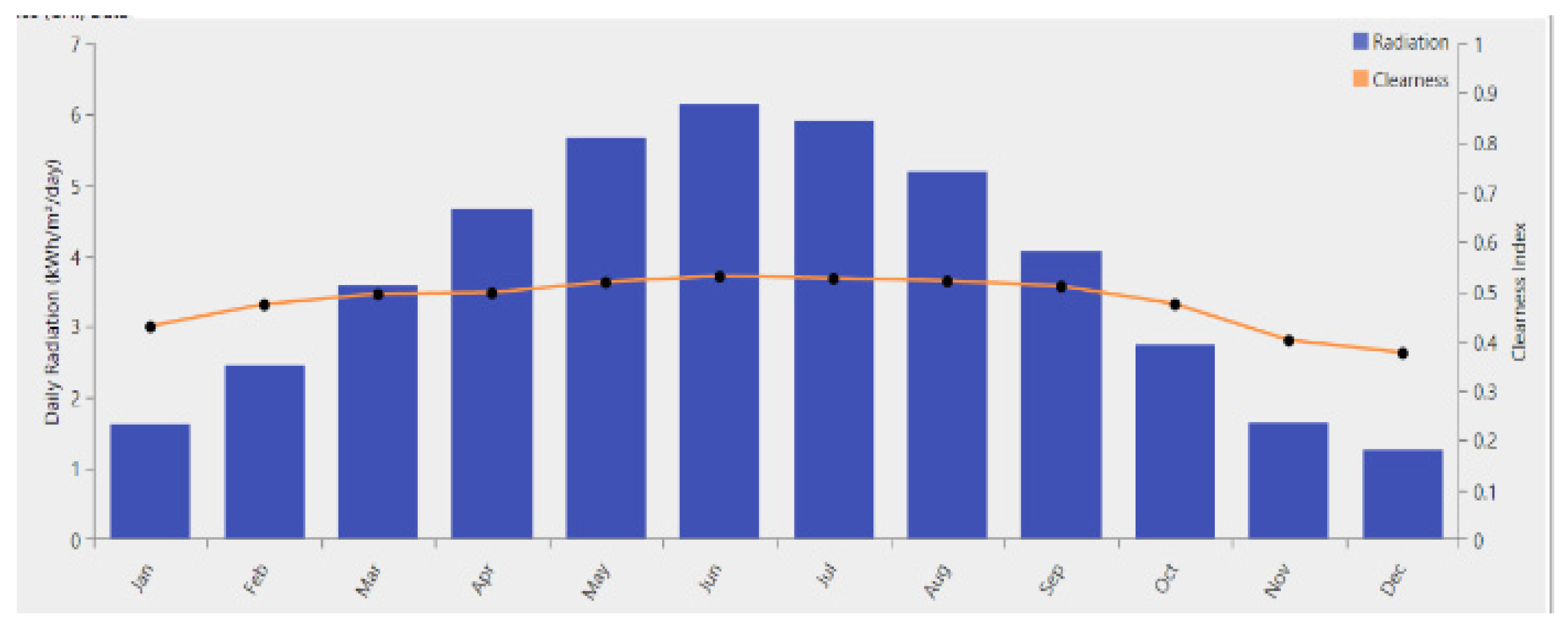
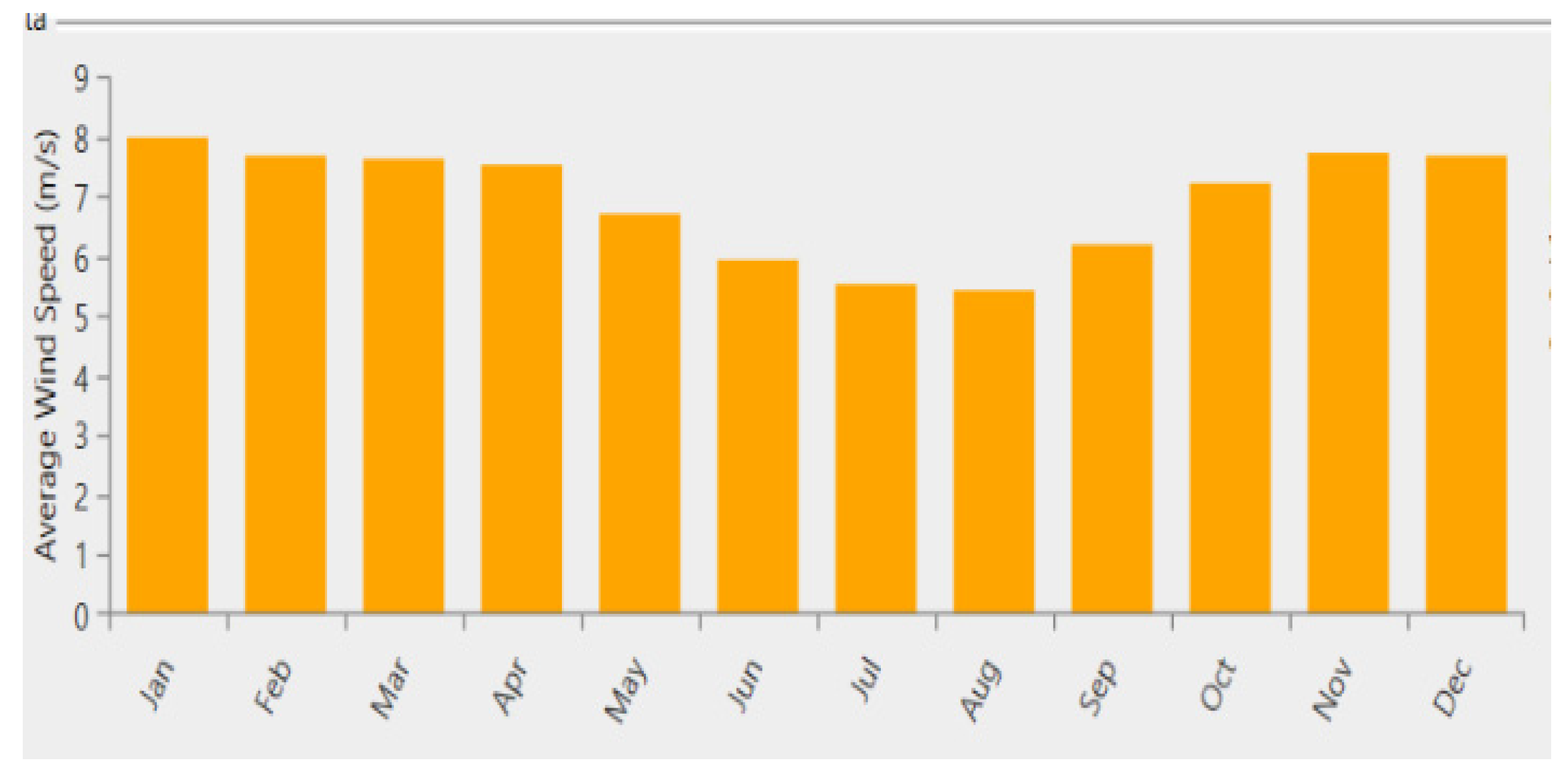
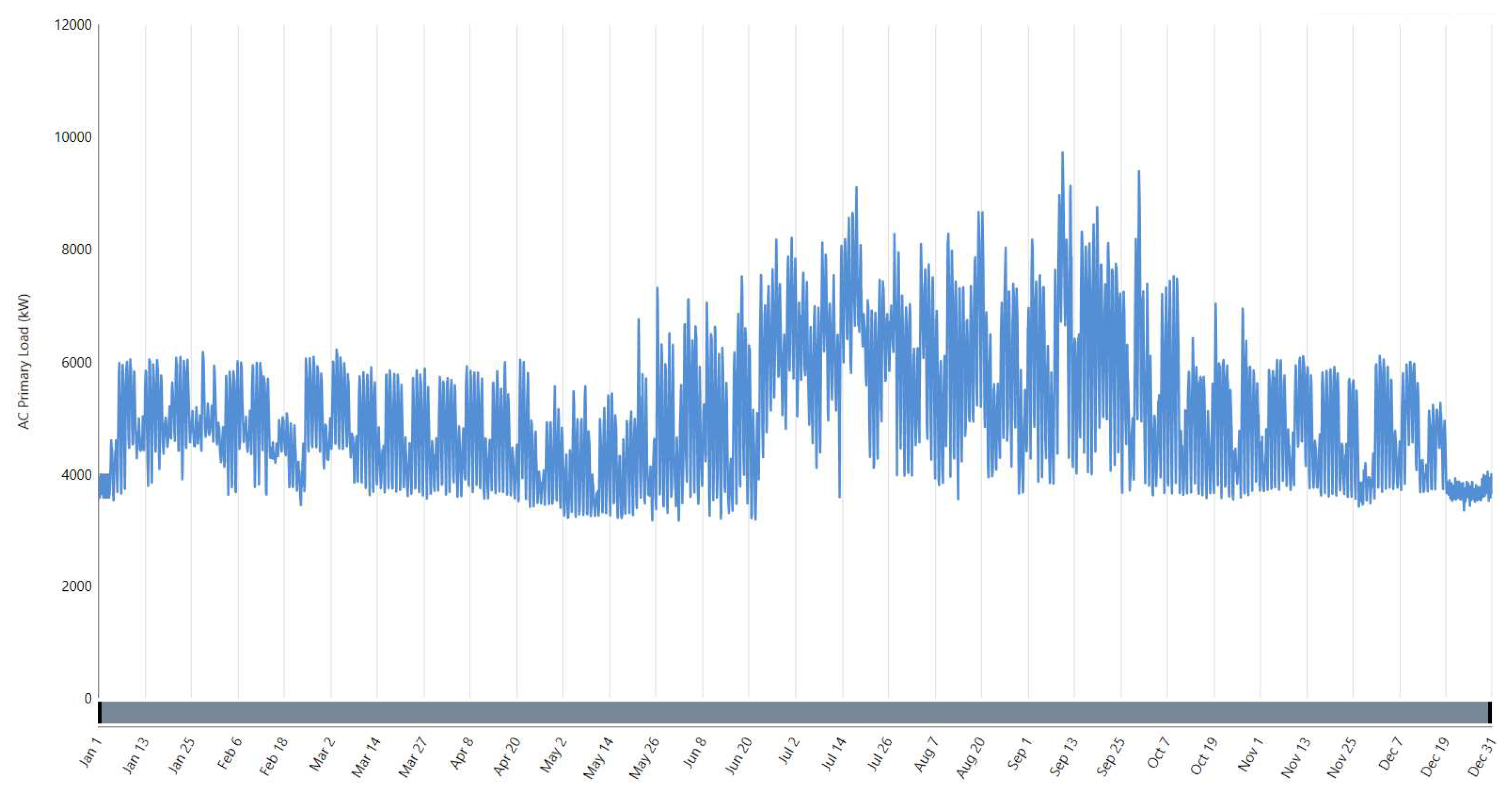
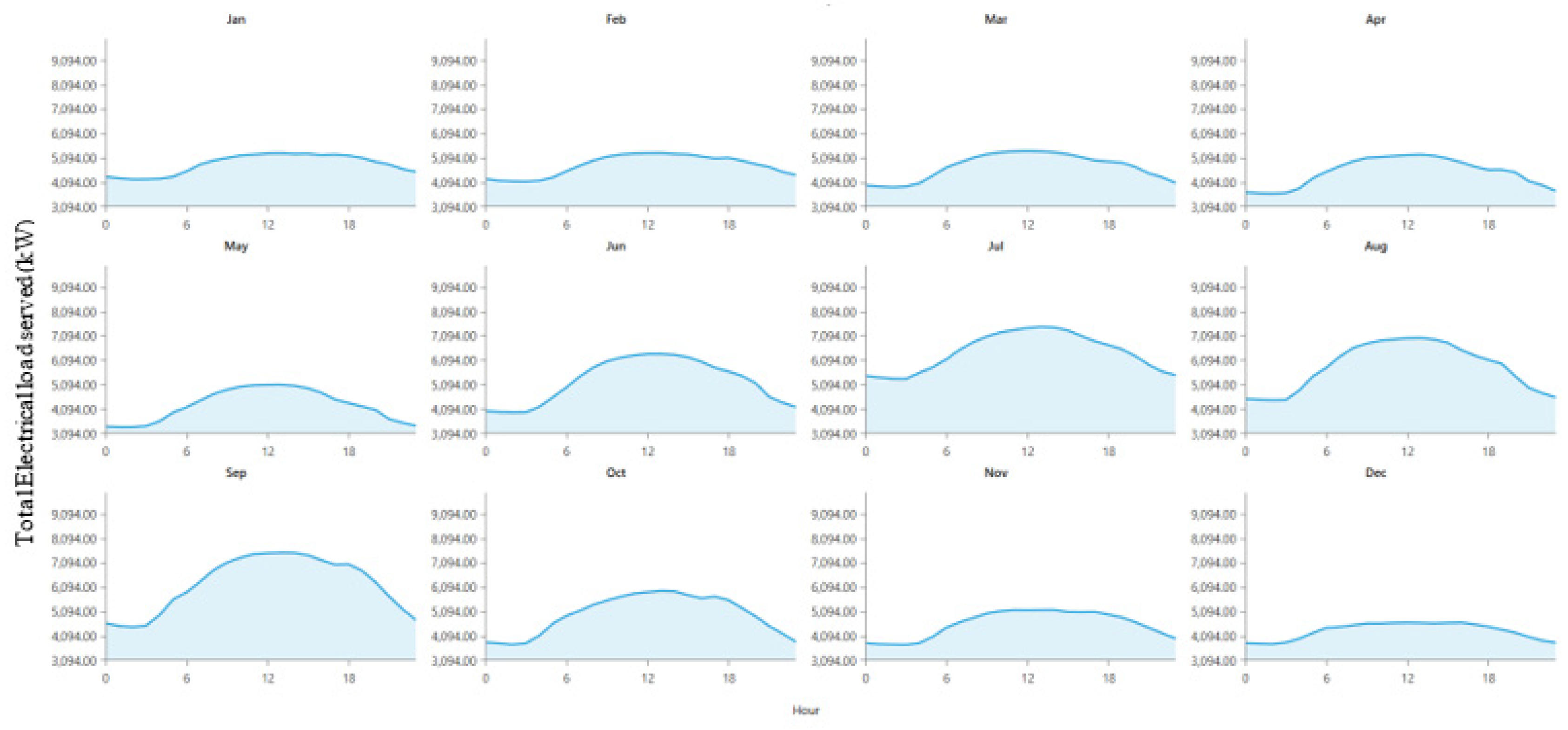

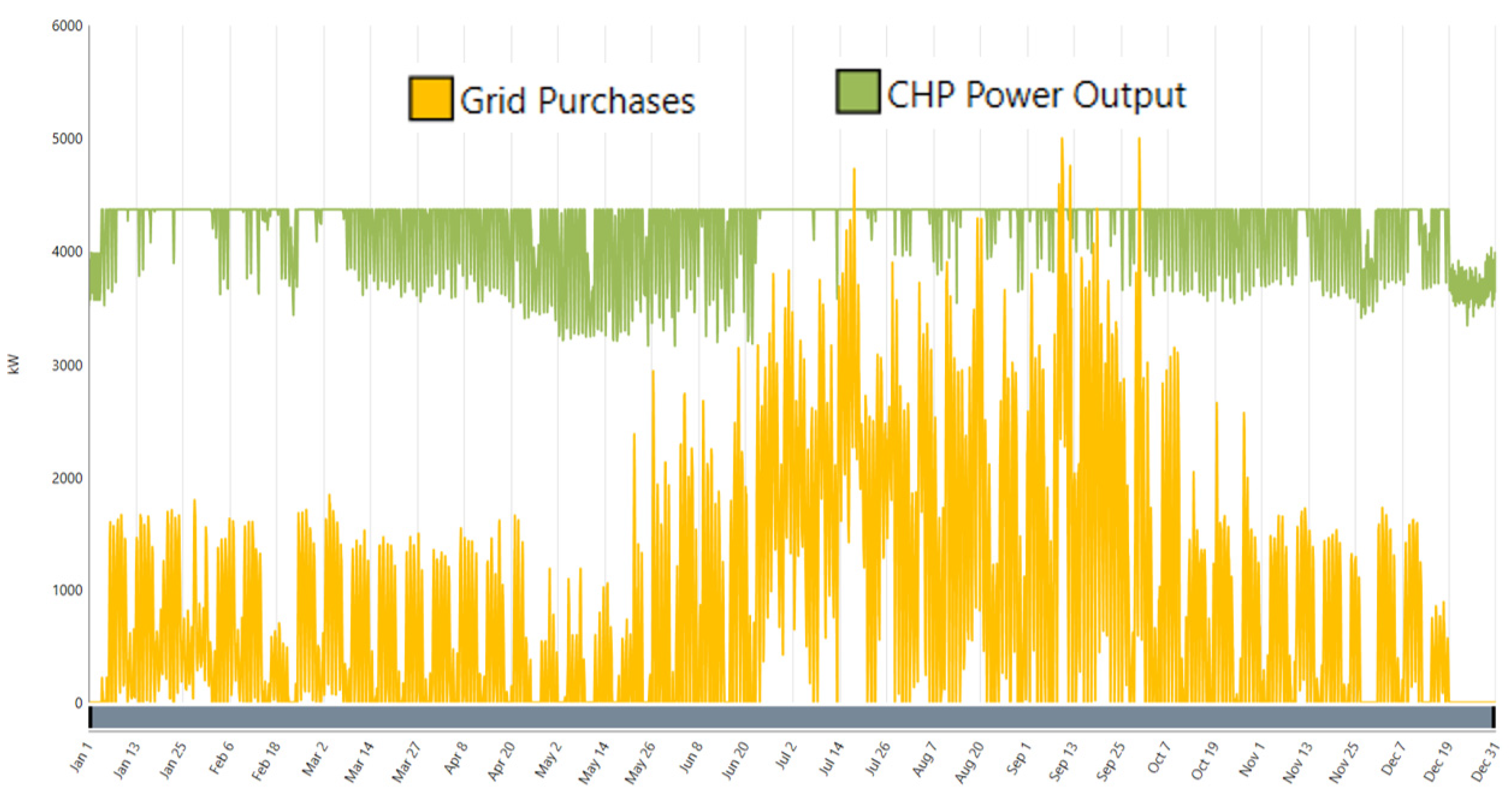

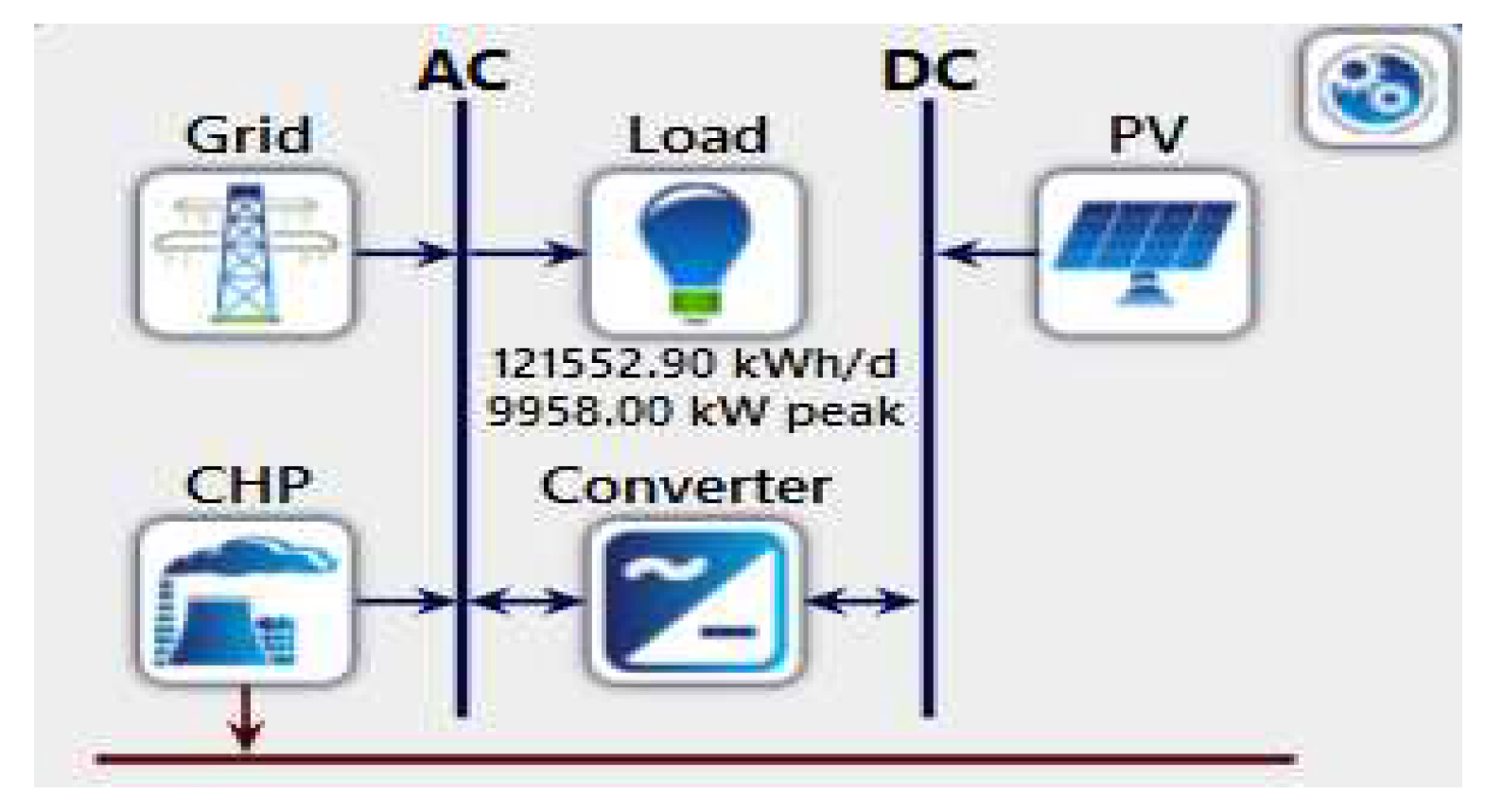
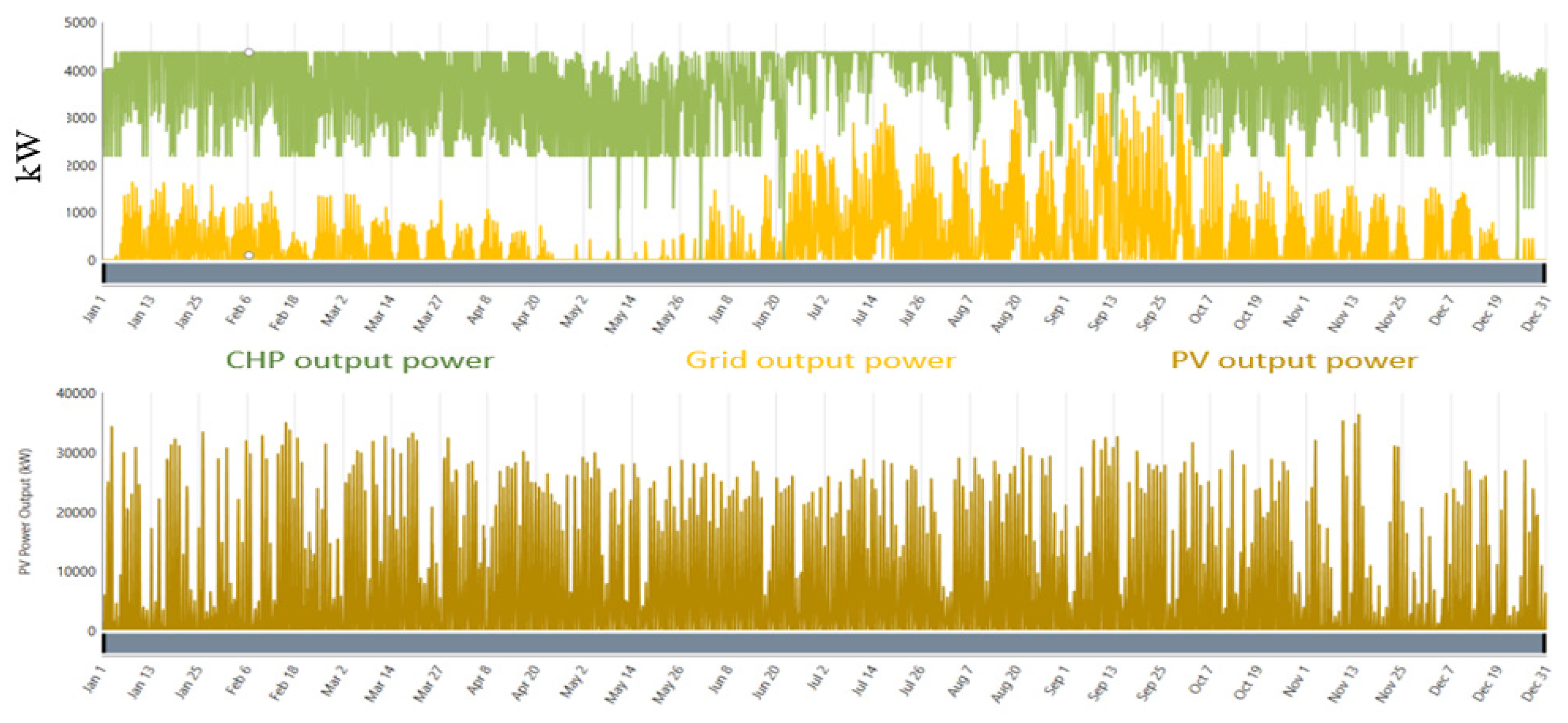
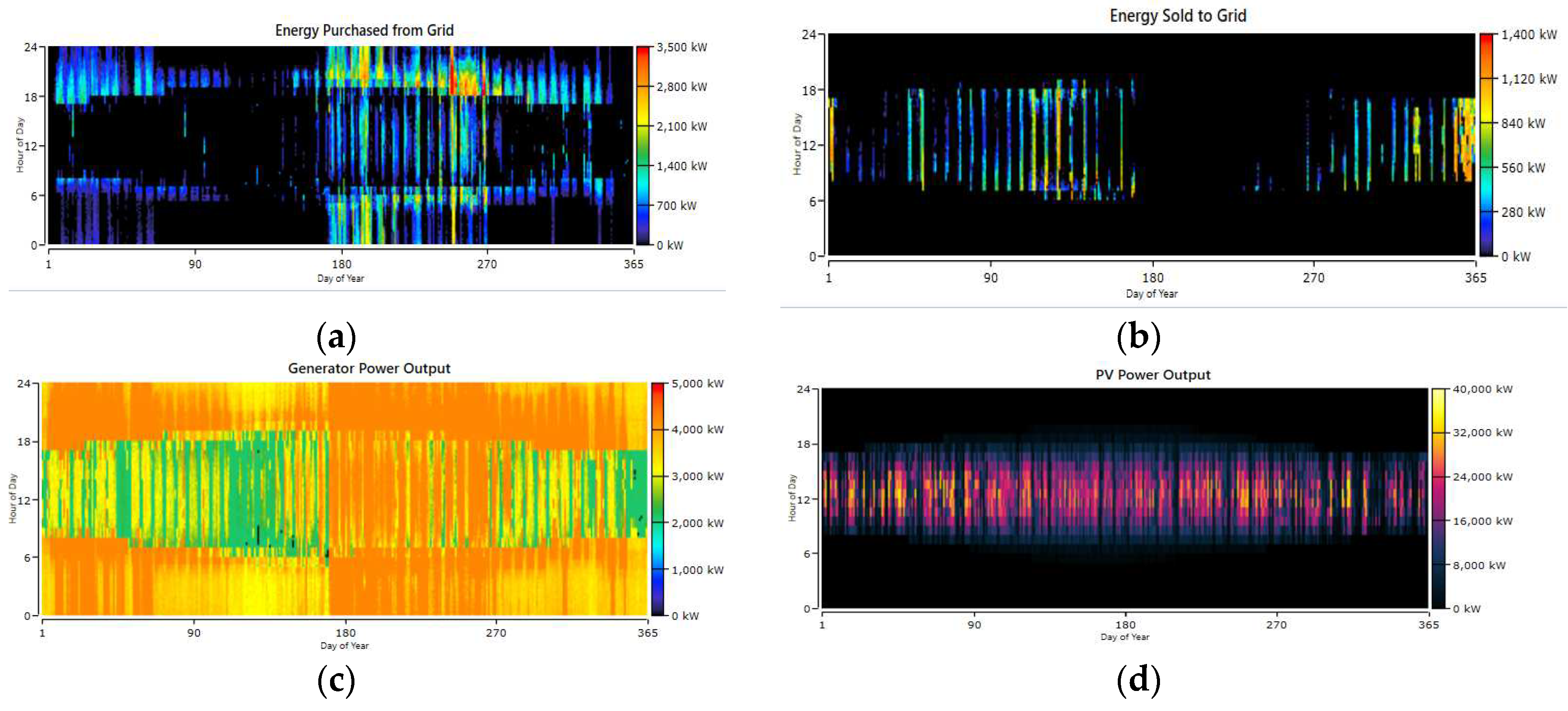

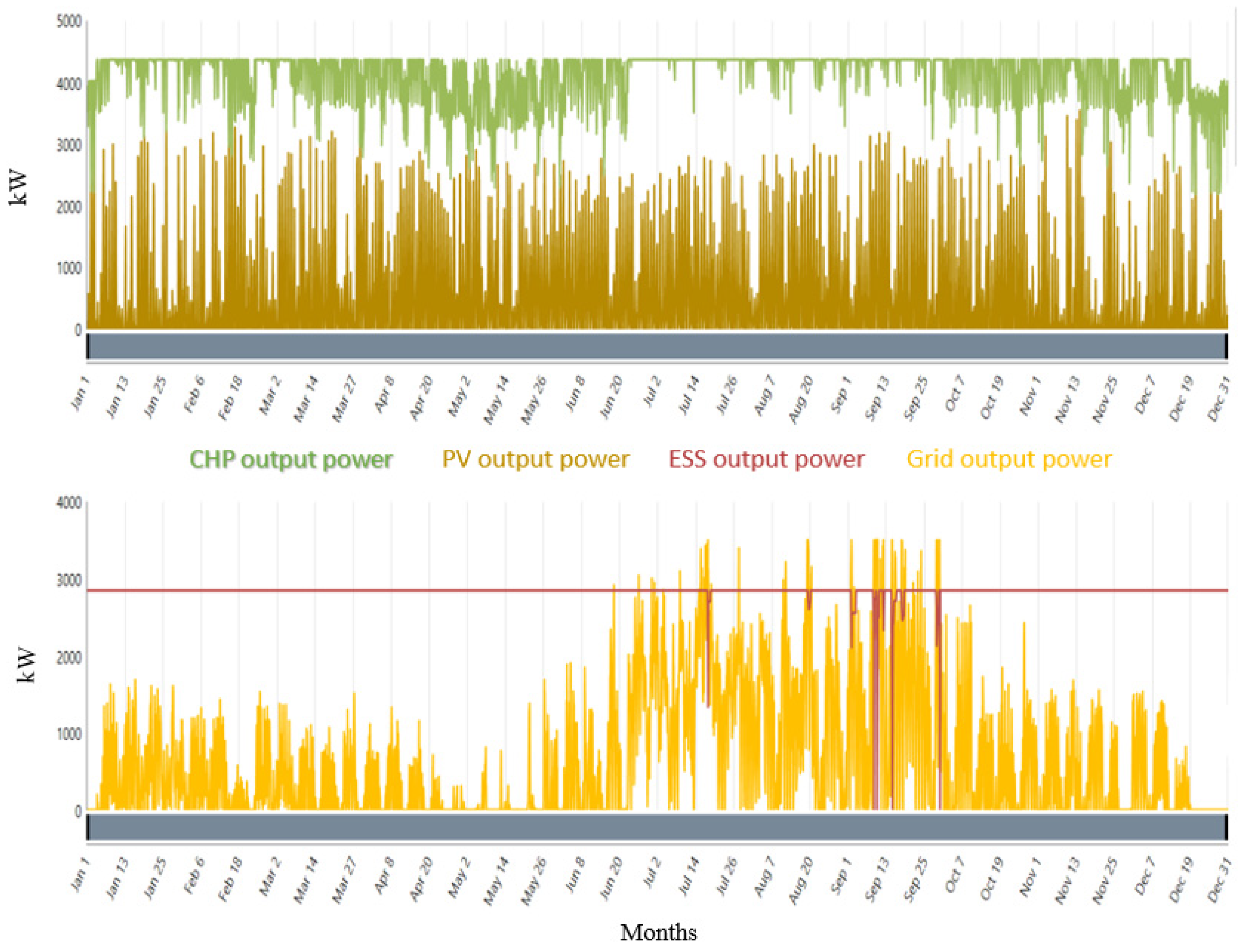
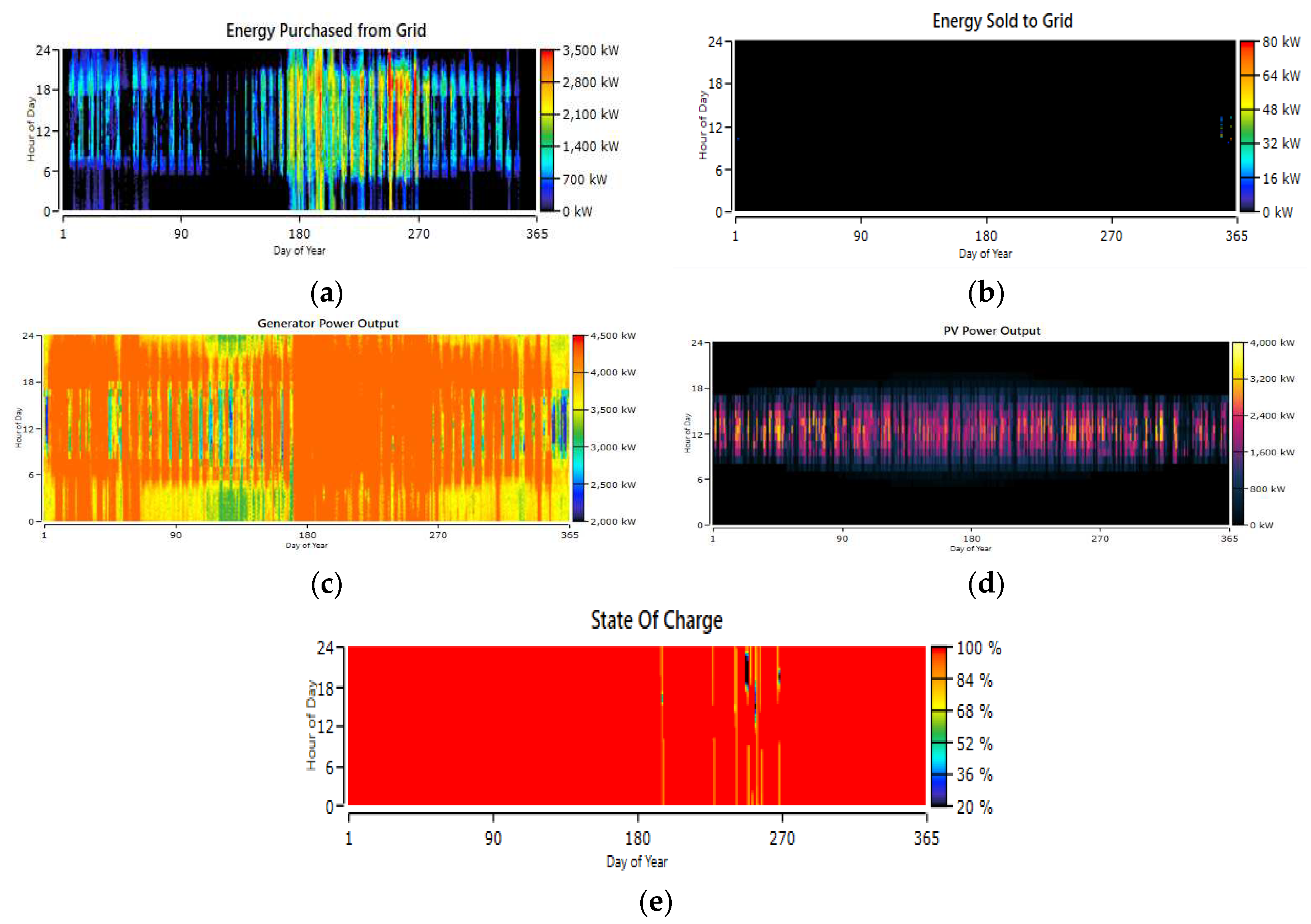
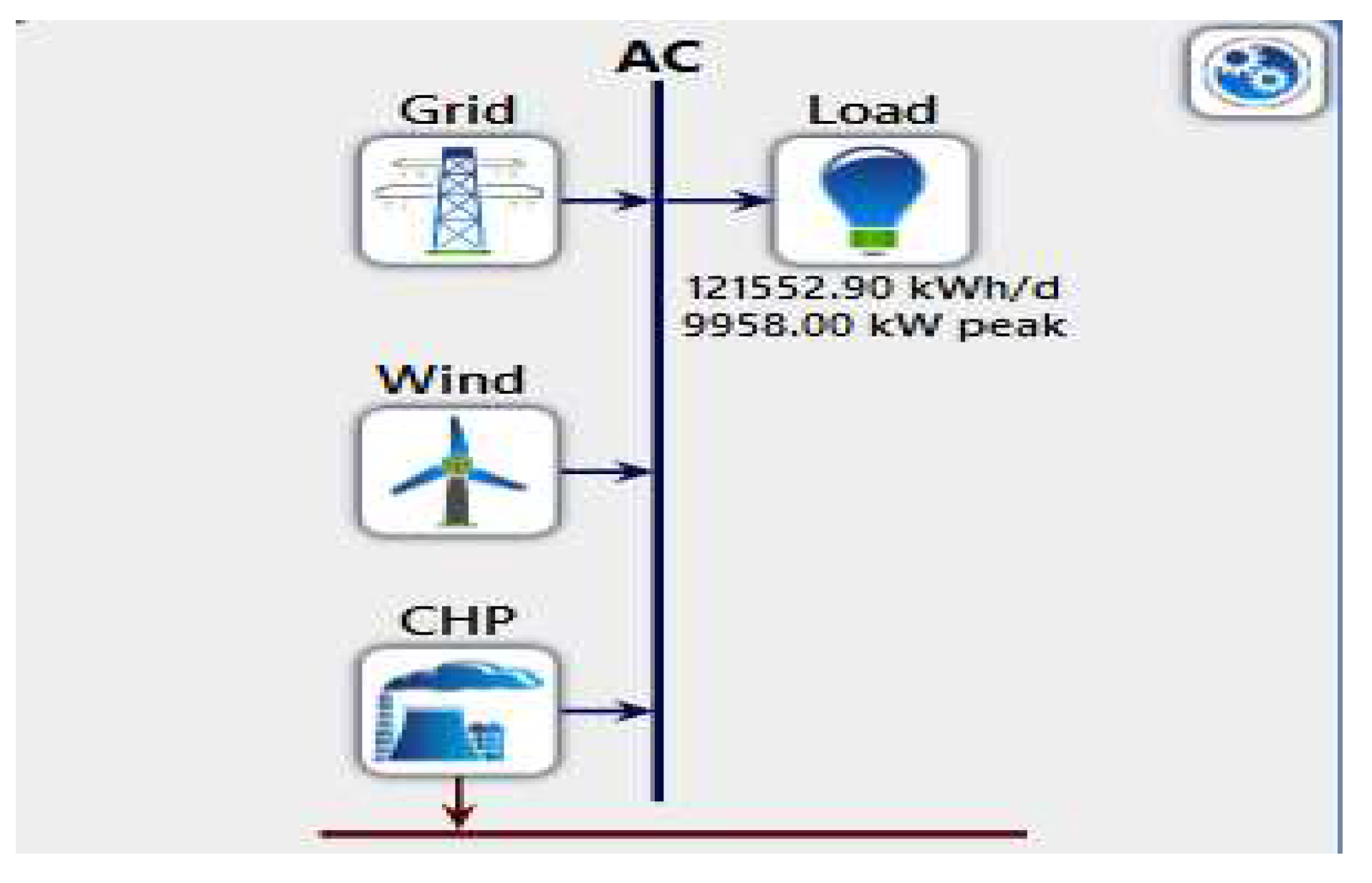
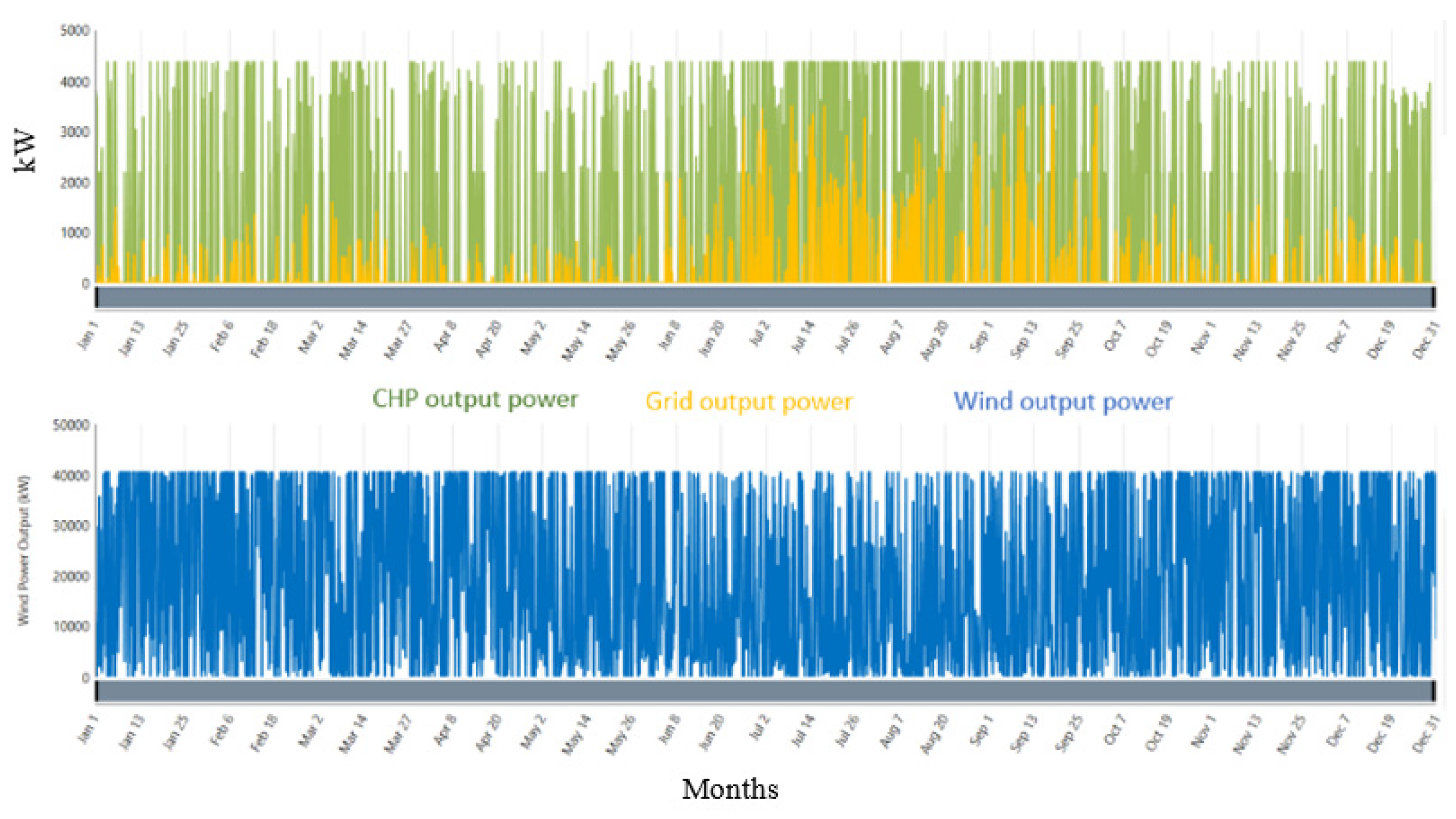
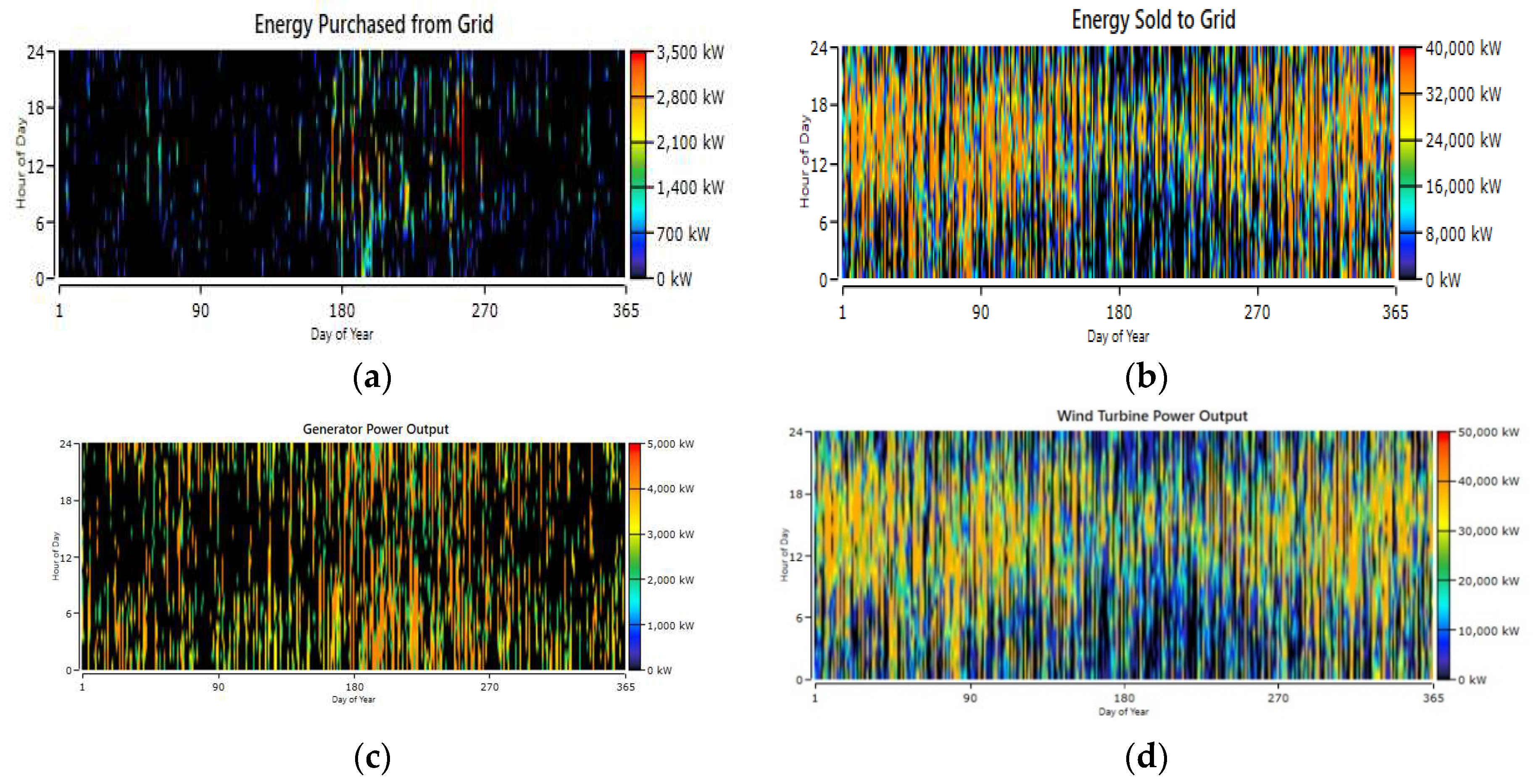
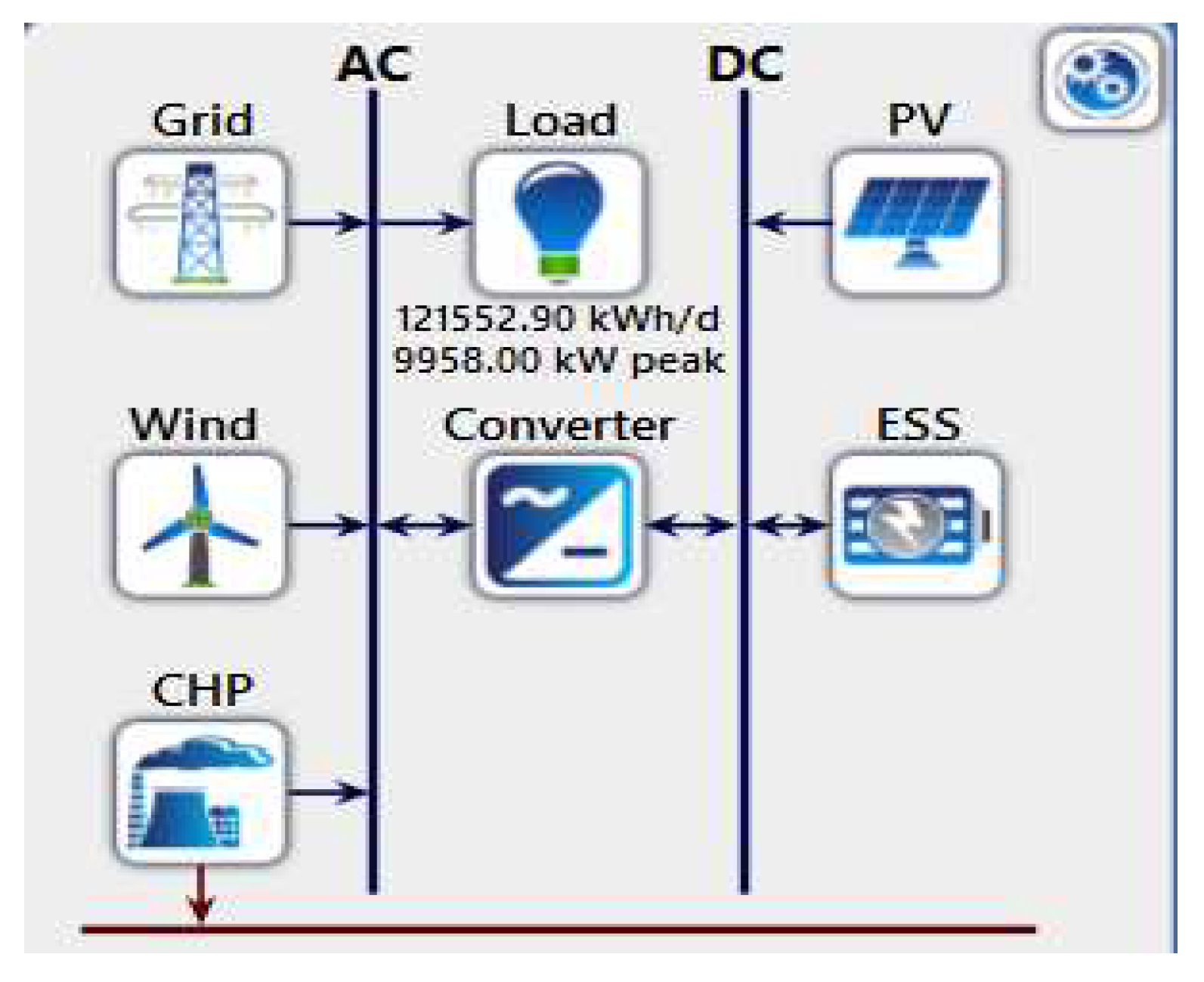
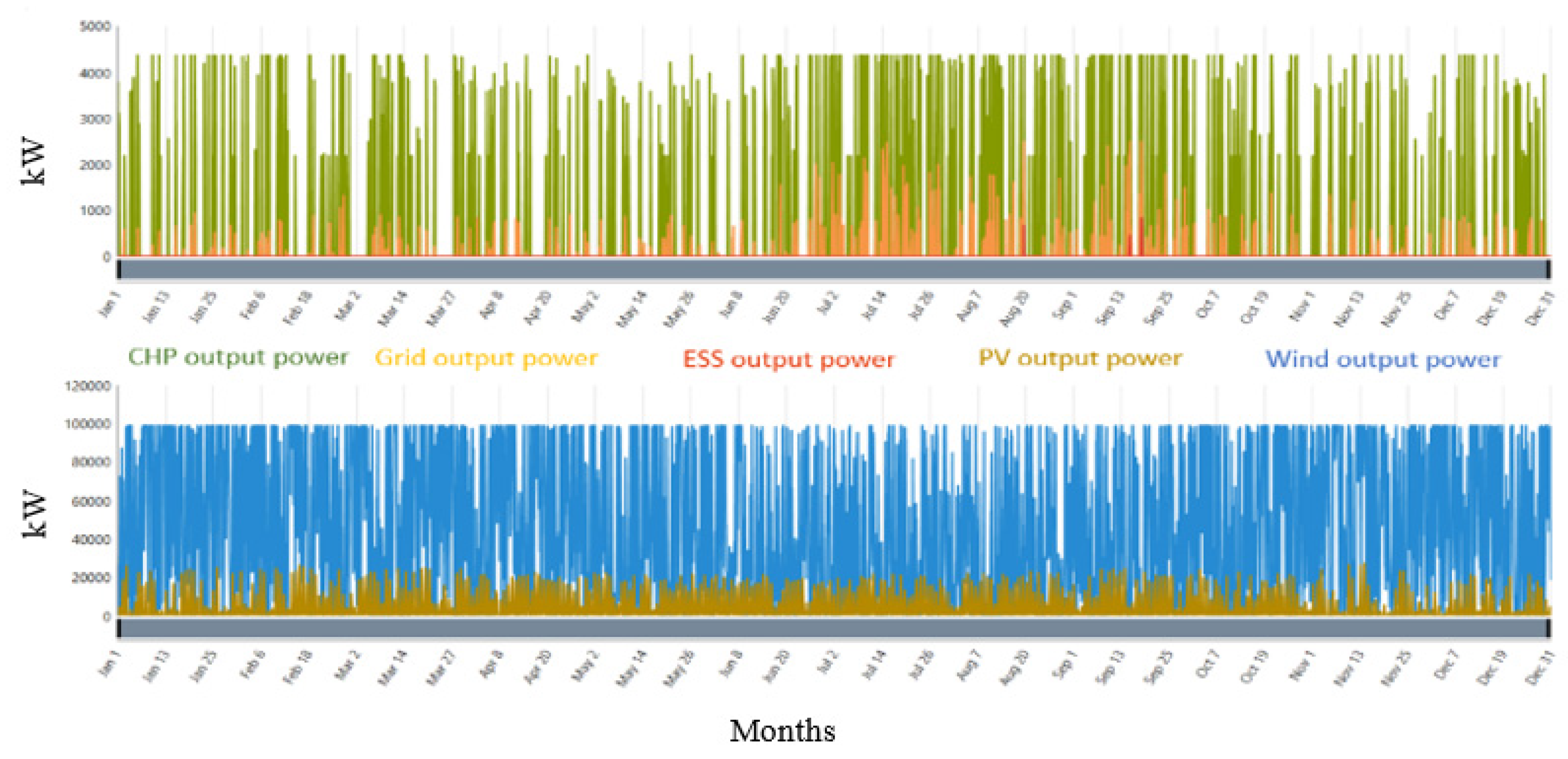
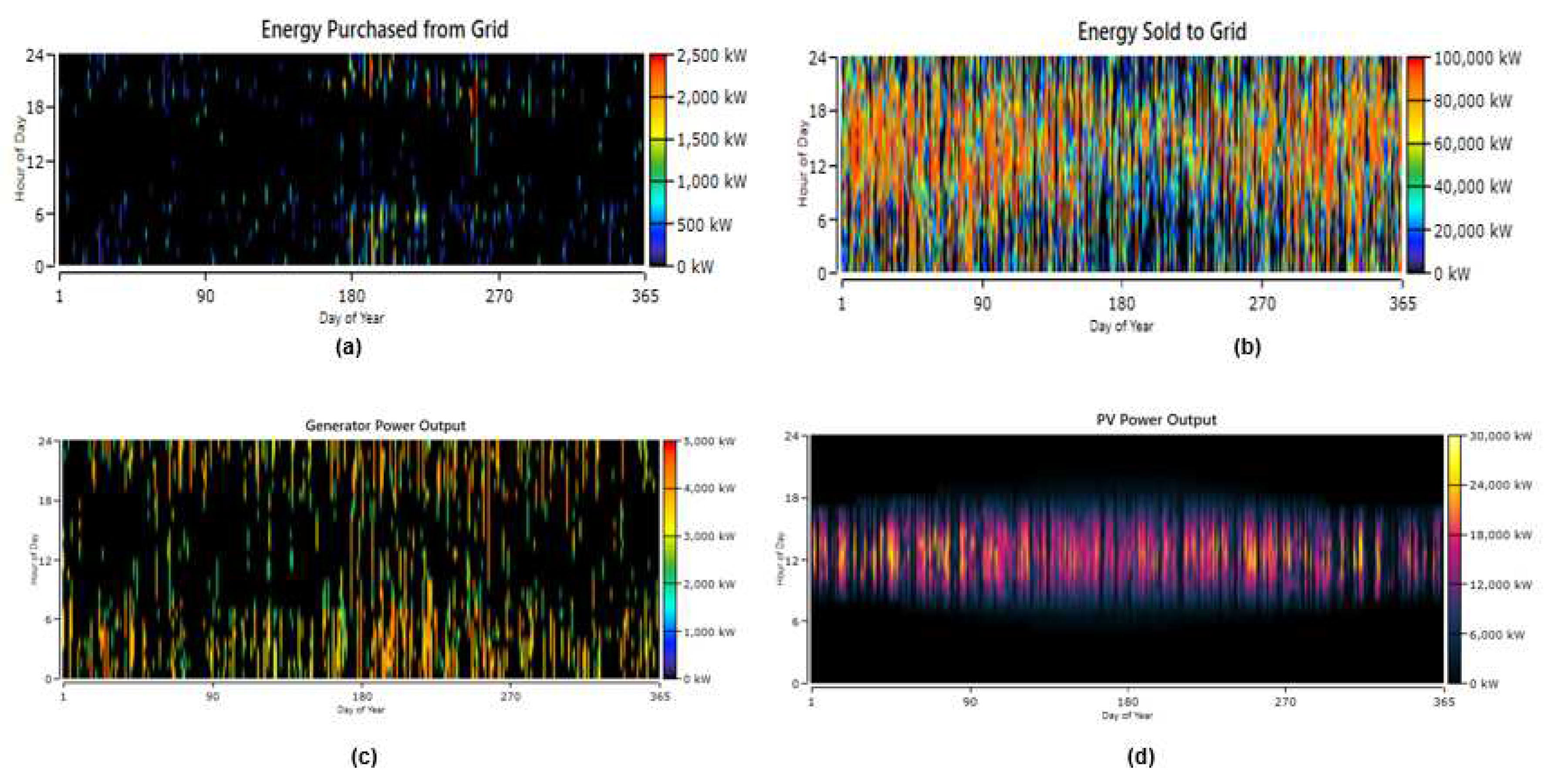

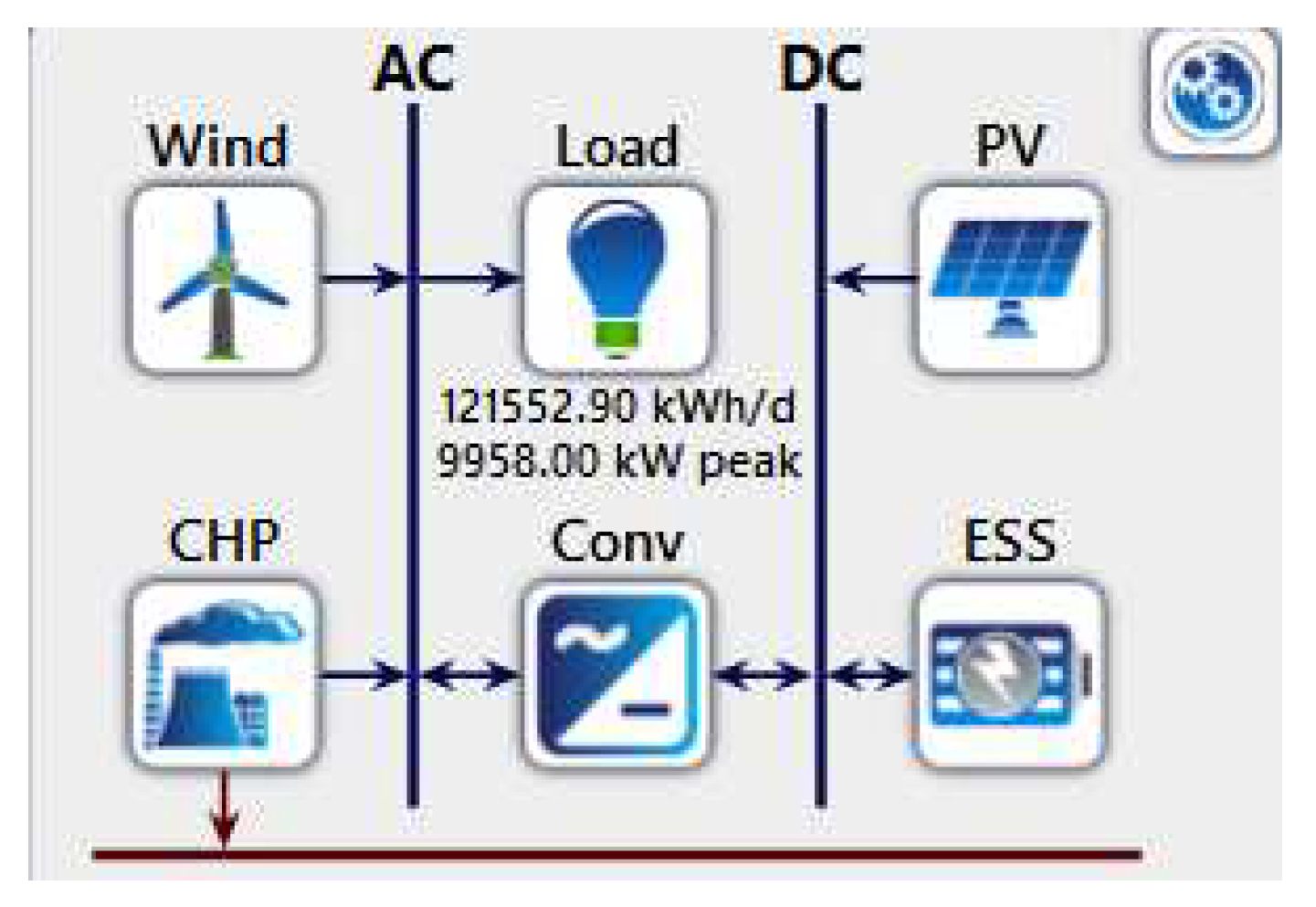
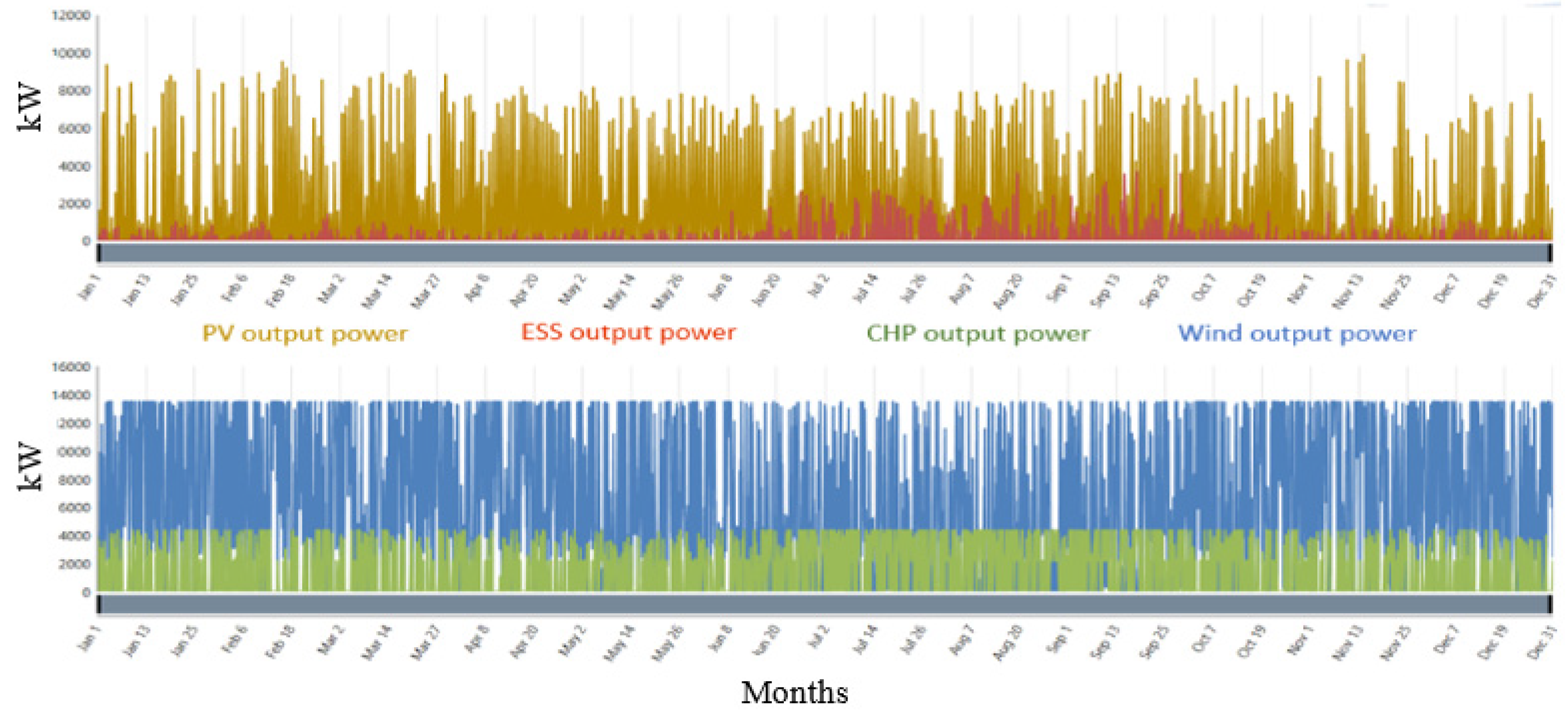
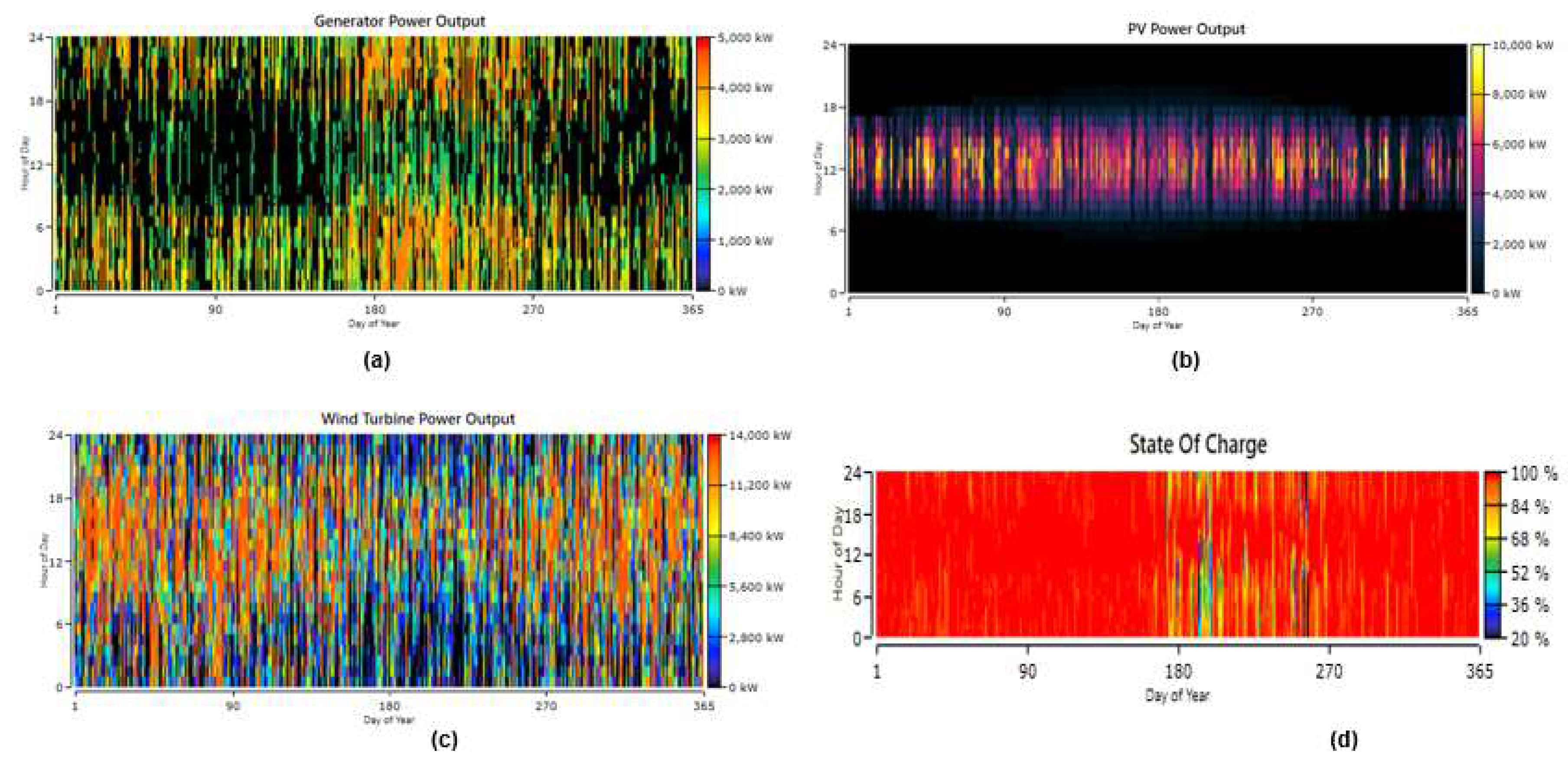
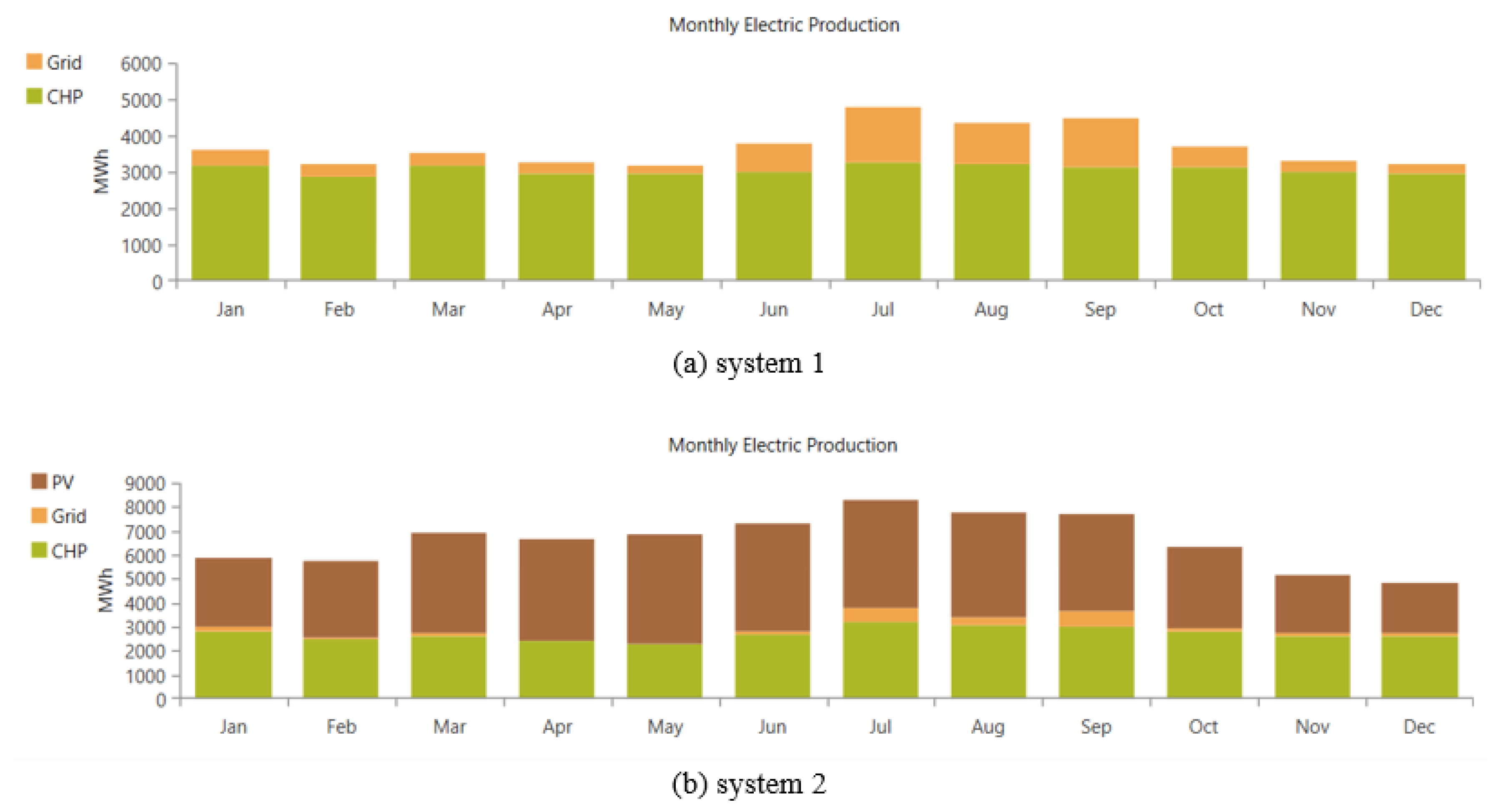
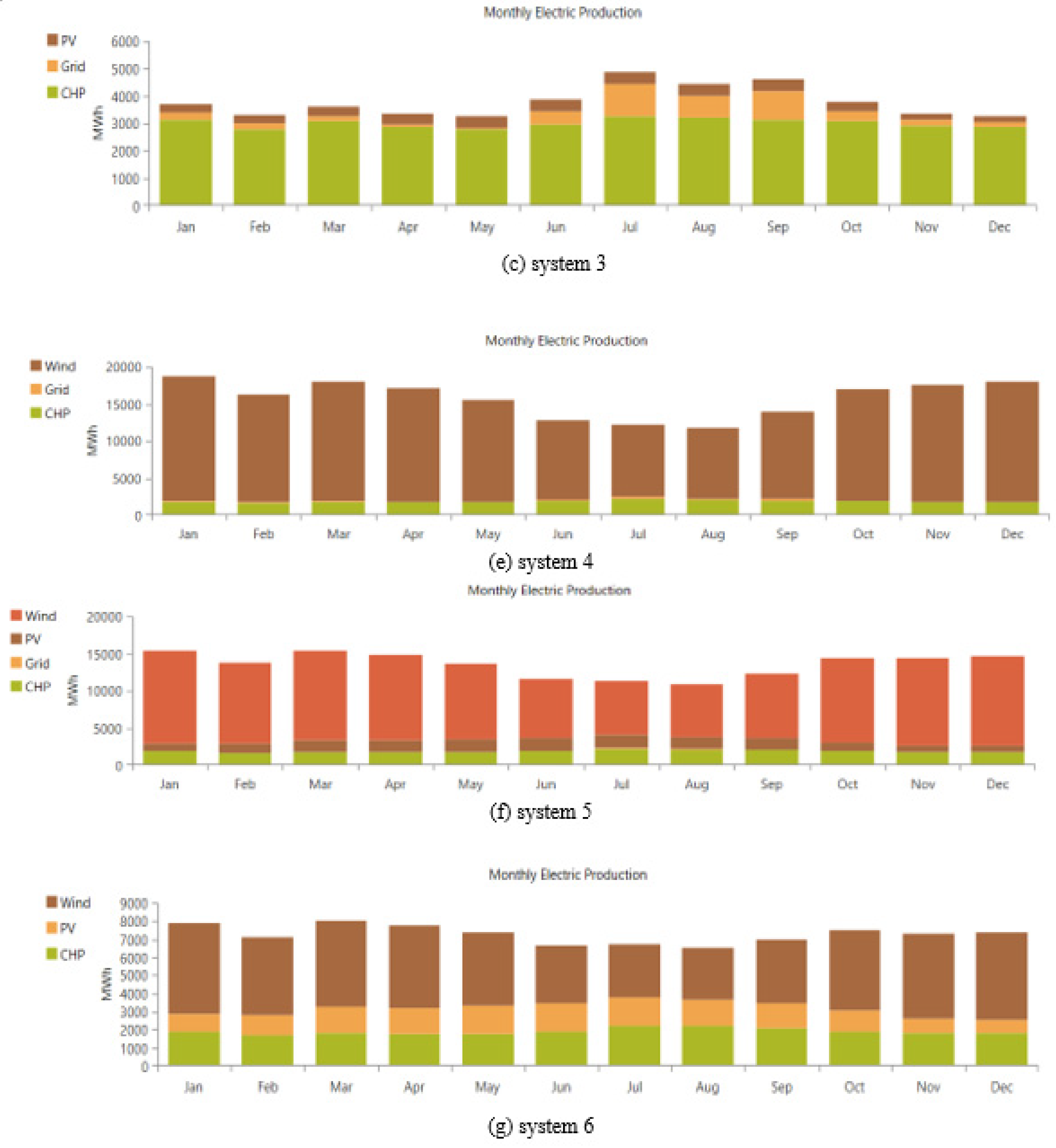
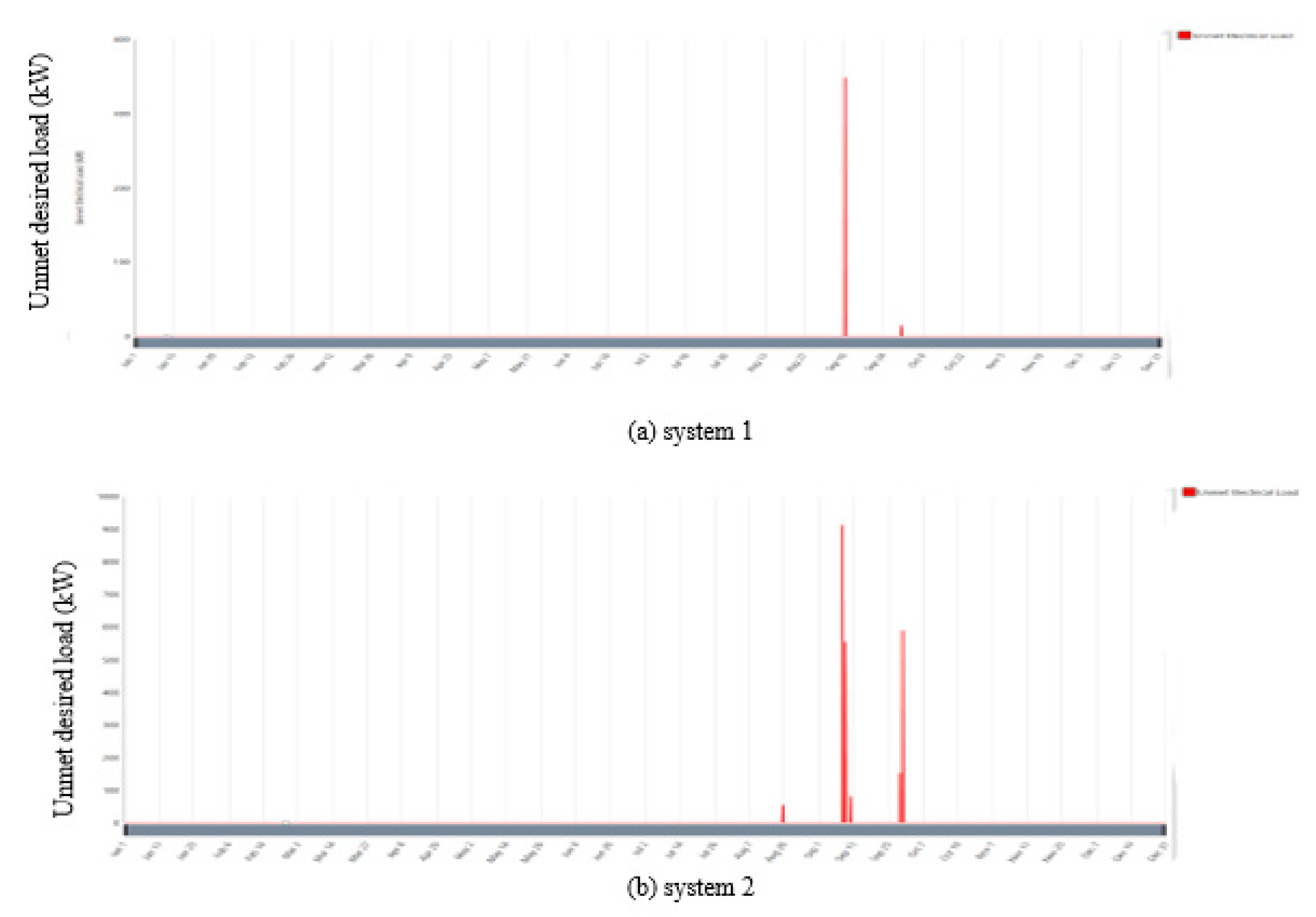

| Reference | Microgrid | Resources | Solver/Methodology | Contribution |
|---|---|---|---|---|
| [30] | On-Gird | WT, PV, Hydrogen storage, Diesel generator, Battery storage, tidal current farm | HOMER/noncooperative game-based planning | effectiveness of the MG interconnection and the annual net cost |
| [31] | WT/diesel generator/PV/battery storage | Arithmetic optimization algorithm, Harris hawks optimizer, hybrid algorithm, Friedman ranking test, microgrid, off-grid, optimal capacity planning, sizing optimization, Wilcoxon signed rank test. | sensitivity analysis | |
| [32] | WT, PV, micro-turbines, diesel/biogas generators, fuel celattery ls,b storage | HOMER | economic feasibility, different load profiles, performances of the batteries | |
| [33] | different configurations (WT, PV, battery storage, biomass, micro hydro) | HOMER | sensitivity analysis | |
| [34] | PV, microturbine | MATLAB | economical costs | |
| [35] | PV, WT | HOMER | technical and economic performance | |
| [36] | PV, battery storage, Biomass, Diesel generator | mixed integer linear programming | Generation Expansion Planning, economic analysis for ascertaining viability , | |
| [16] | Off Grid (Islanded) | WT/diesel generator/PV/battery storage | HOMER/MATLAB Simulink | Utilize different load dispatch strategies (combined dispatch, load following, generator order, HOMER Predictive Dispatch strategy, and cycle charging) |
| [2] | WT, PV, hydroelectric turbine, fuel cells, hydrogen electrolysis | HOMER | combined both distributed and centralized generation and solar thermal system | |
| [32] | WT, PV, micro-turbines, diesel/biogas generators, fuel celattery ls,b storage | HOMER | economic feasibility, different load profiles, performances of the batteries | |
| [37] | PV, Battery | complex optimization techniques | Resilience, climatic conditions | |
| [38] | PV, WT, diesel generator | Multi-objective design,multi-objective evolutionary algorithm (MOEA) and a genetic algorithm (GA) | costs and unmet load | |
| [39] | PV, WT, battery storage, microhydro system, Biomass gasifier | discrete harmony search (DHS) algorithm | Unmet load |
| Component | Manufacturer | Specifications |
|---|---|---|
| Wind Turbine | Composite | Rated power: 1.5 MW, Router diameter: 90m speed class: III hup height: 30m, lifetime= 20 years |
| Photovoltaic | SunPower | Panel Rated power: 335 W, average efficiency: 21%.Model: X21-335-BLK |
| CHP (J624 H01) | Jenbacher | CHP Rated power: 4369 KW, f:60Hz, V: 4160V, fuel: Natural Gas |
| Battery | Idealized homer model | Nominal voltage: 600 Nominal capacity (KWh):1E+03 Nominal capacity (Ah): 1.67E+03 Roundtrip efficiency: 90% Maximum Charge current (A): 1.6E+03 Maximum discharge current(A): 5E+03 |
| System | GRID (kW) | PV (kW) | WT (kW) | CHP (kW) | ESS (No. of battery) Rated capacity for one battery is 1MW |
Converter (kW) | NPC $ | LOCE ($/kWh) |
|---|---|---|---|---|---|---|---|---|
 system 1 |
5000 | - | - | 4369 | - | - | 45.6M | 0.0795 |
system 2
|
3500 | 32288 | - | 4369 | - | 2567 | 94.1M | 0.163 |
 system 3 |
3500 | 3146 | - | 4369 | 1 | 14938 | 52.2M | 0.0911 |
system 4
|
3500 | - | 40500 | 4369 | - | - | 9.6M | 0.000393 |
System 5
|
2500 | 12155 | 30000 | 4369 | 15 | 1494 | 30M | 0.0274 |
system 6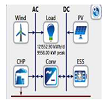
|
- | 10930 | 12000 | 4369 | 32 | 4907 | 88M | 0.175 |
Disclaimer/Publisher’s Note: The statements, opinions and data contained in all publications are solely those of the individual author(s) and contributor(s) and not of MDPI and/or the editor(s). MDPI and/or the editor(s) disclaim responsibility for any injury to people or property resulting from any ideas, methods, instructions or products referred to in the content. |
© 2023 by the authors. Licensee MDPI, Basel, Switzerland. This article is an open access article distributed under the terms and conditions of the Creative Commons Attribution (CC BY) license (https://creativecommons.org/licenses/by/4.0/).





